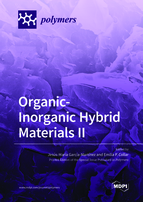Organic-Inorganic Hybrid Materials II
A special issue of Polymers (ISSN 2073-4360). This special issue belongs to the section "Polymer Chemistry".
Deadline for manuscript submissions: closed (31 August 2022) | Viewed by 24699
Special Issue Editors
Interests: polymers and environment; heterogeneous materials based on polymers; polyolefins; interfacial agents; interphase; interface; functionalization; plastic wastes; blends; composites
Special Issues, Collections and Topics in MDPI journals
Interests: polymers and environment; heterogeneous materials based on polymers; polyolefins; interfacial agents; interphase; interface; functionalization; plastic wastes; blends; composites
Special Issues, Collections and Topics in MDPI journals
Special Issue Information
Dear Colleagues,
This Special Issue is devoted to one of the most attractive fields in material science and technology research. The concept of organic–inorganic hybrid materials can be applied to a wide variety of approaches at present, including those considering the matrix of inorganic or organic nature. Hence, the encapsulation of organic functionalities within inorganic matrices obtained by sol–gel processes, the polymerization of organoalkoxyxilanes, and the functionalization of inorganic substances such as micro or nanofillers with organic and/or inorganic molecules able to interact with organic matrixes to provide enhanced properties. In any case, it is the interphase between the components that becomes the critical aspect to consider in research activities with this type of advanced material, thus any effort to enhance and understand these interactions will be key to obtaining these materials with "tailor-made"organized structures at the subsequent nano, meso, micro and macro scales.
Dr. Jesús-María García-Martínez
Dr. Emilia P. Collar
Guest Editors
Manuscript Submission Information
Manuscripts should be submitted online at www.mdpi.com by registering and logging in to this website. Once you are registered, click here to go to the submission form. Manuscripts can be submitted until the deadline. All submissions that pass pre-check are peer-reviewed. Accepted papers will be published continuously in the journal (as soon as accepted) and will be listed together on the special issue website. Research articles, review articles as well as short communications are invited. For planned papers, a title and short abstract (about 100 words) can be sent to the Editorial Office for announcement on this website.
Submitted manuscripts should not have been published previously, nor be under consideration for publication elsewhere (except conference proceedings papers). All manuscripts are thoroughly refereed through a single-blind peer-review process. A guide for authors and other relevant information for submission of manuscripts is available on the Instructions for Authors page. Polymers is an international peer-reviewed open access semimonthly journal published by MDPI.
Please visit the Instructions for Authors page before submitting a manuscript. The Article Processing Charge (APC) for publication in this open access journal is 2700 CHF (Swiss Francs). Submitted papers should be well formatted and use good English. Authors may use MDPI's English editing service prior to publication or during author revisions.
Keywords
- hybrid inorganic/organic polymer-based materials
- heterogeneous materials based on polymers interfaces
- interphase
- functionalization
- sol-gel
- chemical modification
- composites
Related Special Issue
- Organic-Inorganic Hybrid Materials in Polymers (12 articles)







